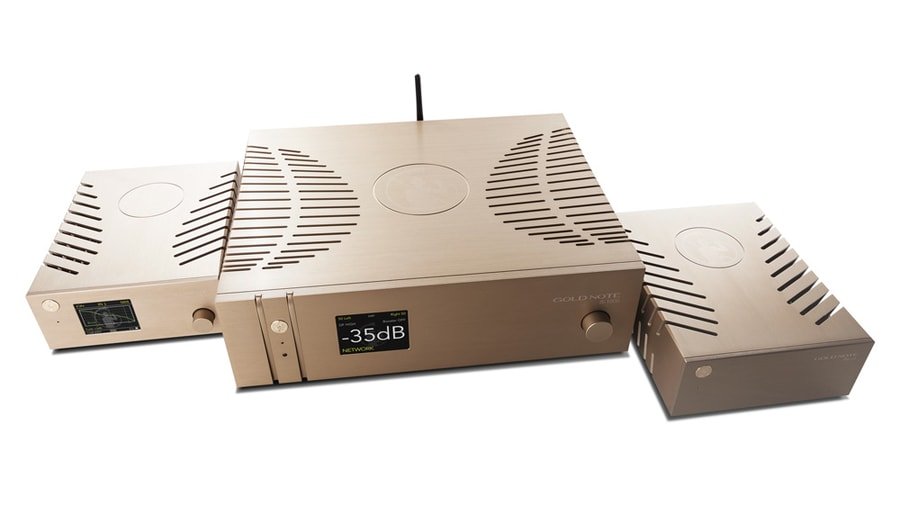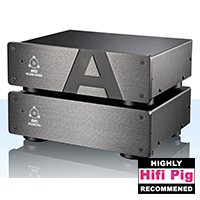GOLD NOTE PH1000 PHONOSTAGE REVIEW
The Gold Note PH1000 LINE phonostage is the Italian company’s highly configurable PH1000 with the addition of a Class-A line-level preamplifier. As tested it costs £11,276 which is a considerable sum, but is it worth that? Stuart Smith has a listen.
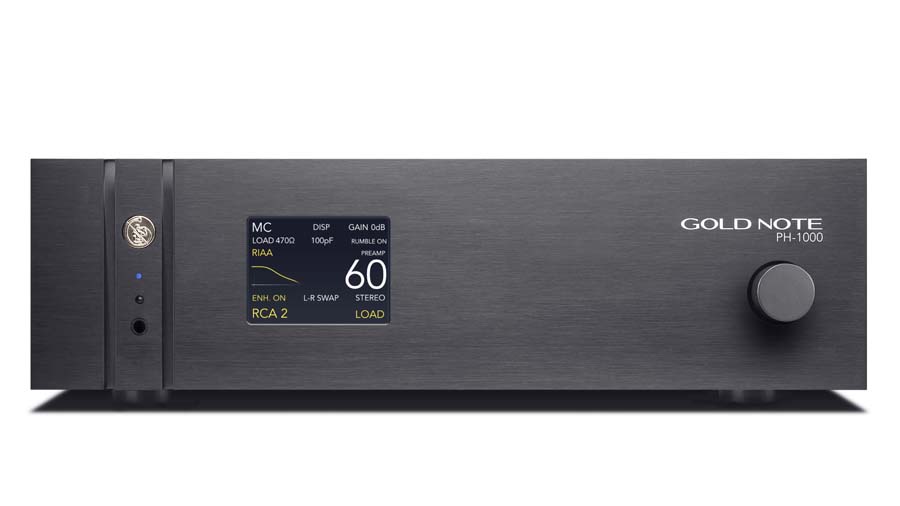
The Gold Note PH1000 Phonostage has clean and elegant lines with just one knob to control all functions – and they are many.
BUILD AND FEATURES
Italian brand Gold Note say that the PH1000 phonostage is the “best phonostage “ they have created and it’s certainly the most pricey phonostage we have ever had in for review at HiFi Pig Towers – the PH1000 LINE costs around £11,276. Gold Note also says that this Italian made phonostage is “innovative in every way”. £11,276 is a lot of money for a phonostage but then it’s the first piece of electronics down the line from your record player and so a vital tool in ensuring the integrity of the signal from your cartridge. However, the PH1000 is much more than a simple phono-preamplifier that amplifies the signal from your cartridge in accordance with the RIAA curve.
There’s no getting away from the fact that the PH1000 is feature-packed. It offers over forty EQ curves to ensure that whatever record you use and whatever curve was used in its production, the PH1000 will reproduce it correctly. In addition to the 40 or so preset curves there’s also the onboard facility to manually adjust four custom curves. I can’t help but think that the PH1000 is going to be overkill for the average user, but then again, I do know that many vinyl aficionados do collect older, pre-standardisation records and for them, the PH1000 may well prove to be an invaluable tool. The sales bumph for the PH1000 mentions RIAA, Capitol, Columbia/CBS, Deutsche Grammophon, Decca London USA, Decca London UK, Decca Mono 78rpm, Epic, HMW, Mercury, RCA Victor, Philips, Elektra, L’Oliseau-Lyre and Parlophone equalisation but also tells us that each EQ curve can be “enhanced” with their “Neumann Cutting Lathe” inspired technology.
In addition to the myriad EQ curves on offer, the PH1000 also offers excellent flexibility with regard to getting your cartridge set up properly. There are 14 gain levels, 12 load levels and then there are 7 capacitance options to fine-tune Moving Magnet cartridges. And then you can make fine adjustments to these in real-time whilst your record is playing.
Whatever parameter you are looking to select or alter, everything is accessed by the one knob, the SKC (Single Knob Control) which makes menu-diving via the information-rich and pretty intuitive front-panel screen.
There’s the ability to switch between stereo and mono, switch the left and right channels and turn the rumble filter on and off.
There’s also an onboard headphone amp.
Now, for me, much of the above functionality is not going to ever get used, despite me having three turntables, several cartridges and a few arms. However, for the vinyl-based audiophile looking to have the ultimate in flexibility to ensure that whichever record in their collection is played with the correct equalisation using a cartridge that has been matched perfectly I can’t see that there are many other options out there. Our LAB12 melto2 has different curves, different loadings and a trio of inputs, but when compared to the Gold Note it looks positively feature-lite.
I ought to mention that as well as this phonostage, Gold Note also have a much more straightforward option available in the form of their PH10 which we gave an Outstanding Product award.
So let’s have a look in a bit more detail as to what inputs the PH1000 has to offer.
Input-wise you have a couple of RCA inputs and an XLR input that all have their grounding posts. In addition and next to each of these inputs you have an RCA and XLR input that are labelled “Phono Load Line” and are there to allow you to further fine-tune the load with external “load-plugs”, though they can both be used as inputs to the PH1000.
Outputs on the PH1000 are an unbalanced RCA and a balanced XLR.
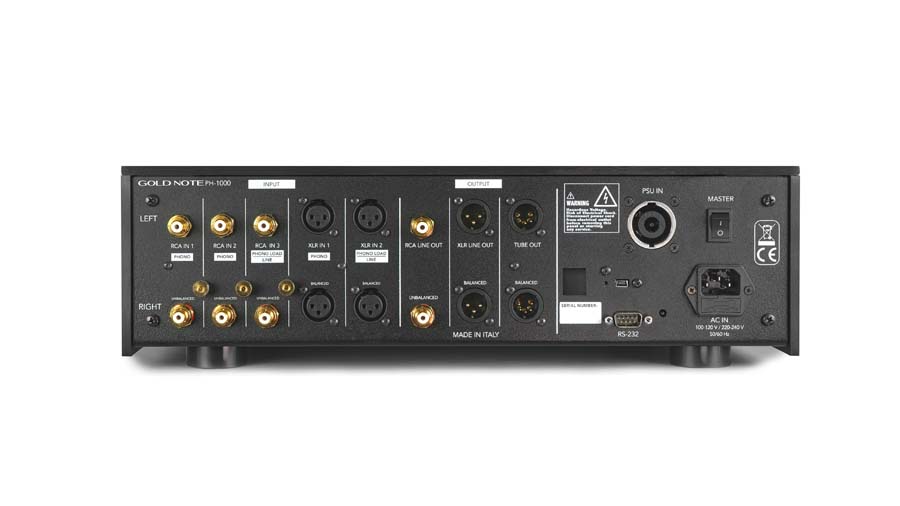
Around the back of the PH1000
In addition, you have the options between a couple of different tube output stages and a couple of power supplies.
But there’s more. The PH1000 comes in a couple of flavours, the PH-1000 that comes without a preamplifier stage and the PH-1000 LINE that comes with a Class-A preamp stage that turns the extra RCA and extra XLR inputs I mentioned into line inputs that allow you to add a CD player or DAC. This latter option is clearly aimed at providing a comprehensive unit for the vinyl-centric audiophile that also dabbles with other sources.
With regards to layout, the back panel is well-spaced and well labelled.
The build quality is pretty stunning and the PH1000 looks fantastically elegant and understated on the rack – we had a black one, but there is a gold (champagne) coloured version too. The PH1000 is normal width and fits on a shelf as any normal-sized bit of kit would, though it is quite heavy at 12Kg. The actual dimensions are 430x135x375mm (WHD).
The remote that comes with the PH1000 is functional but not really in keeping with the styling of the main box. My thoughts on remotes are well known and so I’ll not bang on about them again here.
Updates to the PH1000 are via firmware updates you can download from the Gold Note website.
Let me say now that I am not going to be in a position to test every single parameter available on this phonostage, though I will be throwing a good number of cartridges at it and will try to dig out whatever esoteric recordings using different EQ curve that I have in my collection.
All this functionality is pretty dizzying but in use the PH1000 using the SKC is pretty straightforward, though it did take me a moment to get the hang of moving about the screen with it. Press the knob to highlight the box outline and then move it around the screen by turning the knob left or right until you get to the parameter you want to change, click the knob again and you can change the value. Like I say, easy to get your head round pretty quickly, though you can use the remote if you prefer. There is no obvious button for on and off on the front panel, which confused me somewhat until I bothered to read the user manual – press the SKC for a few seconds and hey presto!
Set up is a doddle once you get your head around the SKC.
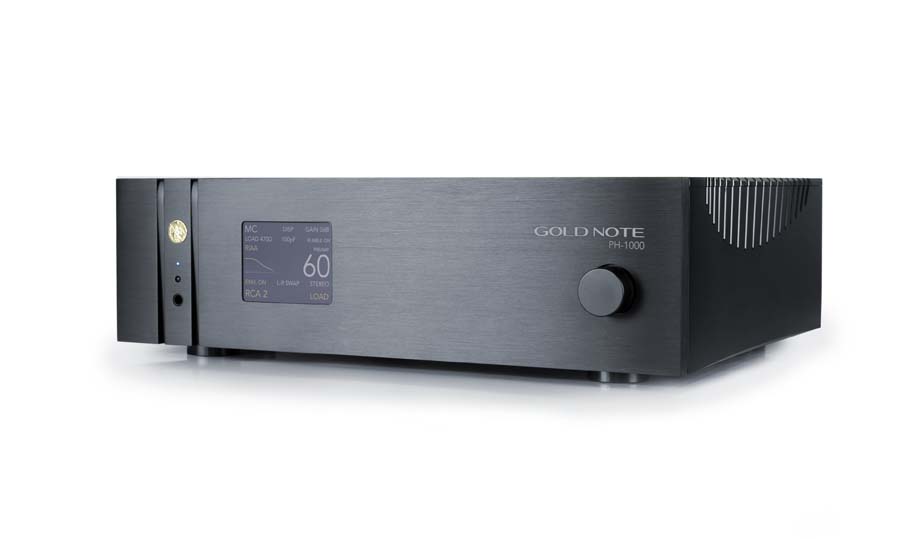
As well as the one control knob, the PH1000 sports a clear screen and a headphone socket.
SOUND QUALITY
As with any product that comes in for review it’s necessary to take my own personal circumstances out of the equation as much as possible and try to put myself in the position of the folks that the product is directly aimed at. I will say now that when looking at the number of variations of EQ curves available on the PH1000 it is clear that I’m not the specific market. However, I do use several arms and cartridges and the adaptability of the PH1000 in this regard is highly useful. The question then arises that I personally would be paying a premium for features I am unlikely to use at the moment. Yes, I’m aware I’m straying away from the Sound Quality part of the review, but I feel this needs to be addressed to preface what comes next. Now, being a member of several Facebook groups I do know that there are avid collectors of rare and exotic vinyl out there – and they are more prevalent than you would imagine – and for these people and archivists, I believe the PH1000 and its myriad EQ options will prove a highly valuable, if not essential tool.
Back to what I’m supposed to be talking about.
I started off using the PH1000 with our Hana Umami cartridge. It’s a relatively new addition to the cartridge stable here at Pig Towers but it has barely been off the arm since it arrived, despite it not being the most expensive cartridge we own.
First of all the PH1000 is deadly quiet and as far as I’m concerned adds no noise into the system whatsoever when in use when the fixed line output is used into an external preamplifier, but I did experience a little background noise when using the amp in preamplifier (STAGE) mode (This allows connection directly to a power amp, allows variable volume control and makes much more sense of the price – a turntable, the PH100, a power amplifier and a set of speakers and you are ready to go, saving on the price of a preamplifier into the bargain. If you don’t want to go this route you can add a preamplifier or use an integrated amp and pop the PH1000 into fixed mode. For much of the review, I used the PH1000 in FIXED mode where the volume is set at 100% and into a preamplifier though I did also use it as a standalone preamplifier.
Using Erykah Badu’s Mama’s Gun with the PH1000 set to the RIAA curve it’s clear that this phonostage really excels through the midrange, bringing a level of realism and detail to the vocal performance, despite the main vocal being heavily processed. The vocal is projected into the room and isolated in the mix in its own space hovering above and between the loudspeakers. But this midrange clarity and fluidity is not at all at the expense of the other frequencies; even at low volumes the bass drum kick on Penitentiary Philosophy has depth and shape to it. Percussion on Didn’t Cha Know, like the vocal, sit in their own space and don’t get lost in the mix. Hats have a snap and rightness to their sound. When compared to our LAB 12 melto 2 there’s a small degree more sparkle and shimmer to the upper frequencies that add a smidge more openness to the music – it’s not a huge difference in presentation but it is there and the melto sounds a little more rounded off at the top end in comparison.
Next up I put on the Vertere Sabre moving magnet and using the same test tracks there’s a little background surface noise apparent, but that’s down to the difference in cartridges and stylus profile more than anything to do with the PH1000. There’s still the same sense of elements of the mix occupying their own space but it’s less pronounced than with the Hana Umami in place. And this is the thing, we aren’t here to compare cartridges but what is apparent is that the PH1000 allows the individual character of your chosen cartridge to shine out. Of course, the phonostage, to use a suitably porcine phrase, isn’t going to make a silk purse out of a sow’s ear and I would recommend that you use the best cartridges you can afford with this stage as I suspect it will highlight inadequacies in this department in a heartbeat. Fortunately, the cartridges we have selected here have been chosen carefully!
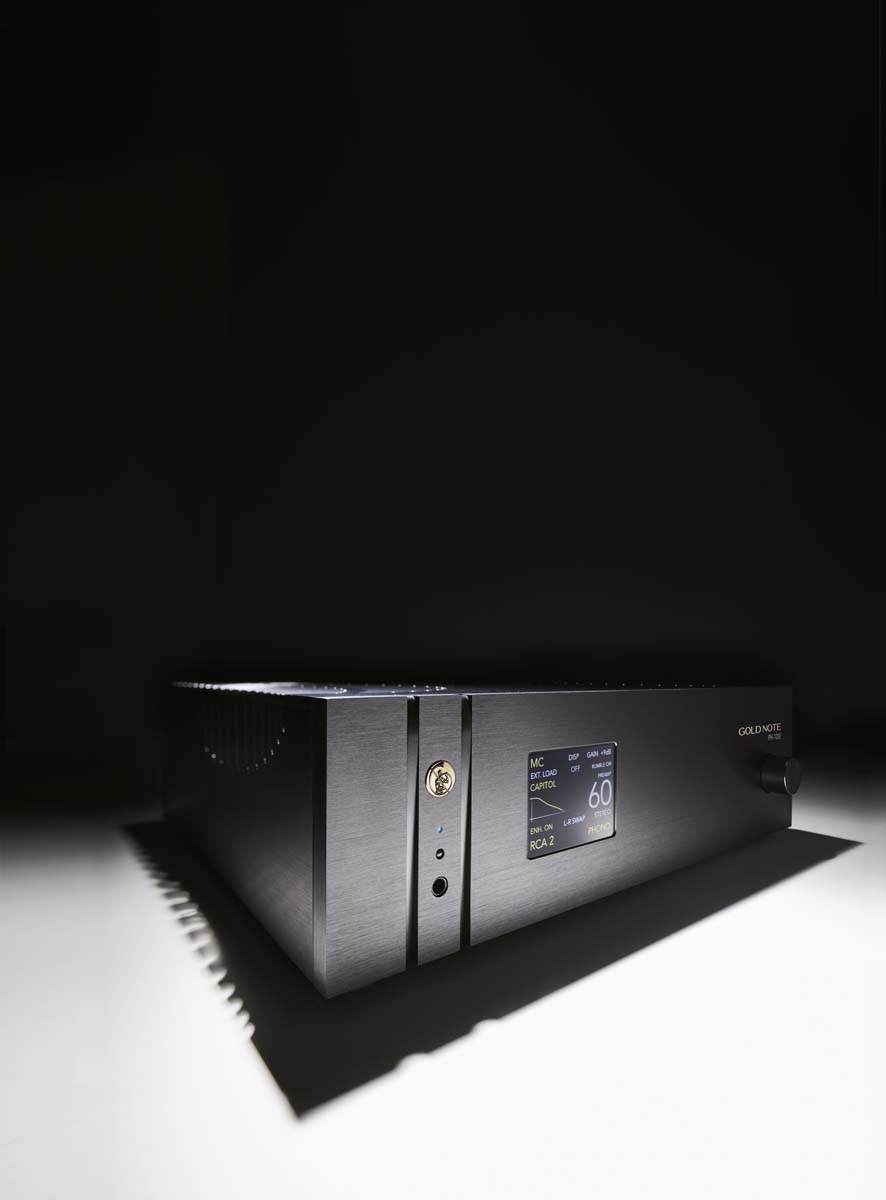
Our review sample was in black but the PH100 is also available in gold – not unsurprisingly.
Moving over to the rarely visited rack of classical records and a copy of Bartok Concerto for Orchestra, a mono recording on Decca and set the PH1000 up accordingly. The recording sounds as fresh as a daisy. There’s the same sense of dynamics and scale as previously encountered and being able to dial in a different curve and mono is useful. Now, here’s the thing; I have a lot of old classical records, and perhaps many more than many would suspect given my usual listening fodder, but I’m far from an expert on the genre or the recording/mastering processes used, though I have a basic understanding. However, it is relatively easy to look up records on Discogs and find the year of production, the label etc. and so a good guess as to whether it is a standardised RIAA recording or something more “exotic” can be made. If you want to read a little more on this subject then this article by HiFi Pig’s own Janine Elliot is a good starting point.
Clearly, this phonostage/preamplifier is aimed squarely at the serious vinyl user, but the LINE level inputs make it a fully-fledged preamplifier, and a very good one it is too. The same transparent and dynamically engaging sonic signature is apparent on the line-level inputs and I found it a seriously entertaining listen into our LAB12 amp. I’d definitely rank the preamplifier stage of this amp as being excellent, though it does add considerably to the cost of the base model (£11,276 v £7,975).
On the front of the PH1000 is a quarter-inch headphone socket. I gave this a quick listen and it’s absolutely good enough for all but the most headfi-centric vinyl lover.
QUIBBLES
There is no getting away from the fact that however good sounding this phonostage is, and it is very good, it is going to be far too sophisticated a product for the majority of people. Now, I say that, but there are certainly going to want this phonostage just because it can do all this much in the same way people buy a Ferrari knowing full well that they are only ever likely to use it to its full potential on track days. I can see people buying this phonostage and then searching out records that it can reproduce the EQ curve for.
The remote is good quality but not in keeping with the unit itself.
The SKC takes a few moments to get used to and can be a bit jumpy, other than that it’s pretty simple to fathom.
CONCLUSION
The PH1000 is an excellent sounding phonostage in its own right giving up a dynamic and detailed presentation that is strong through all the frequencies but with a slightly pushed midband presentation that really makes vocal performances pop from the mix and into the room.
On large scale recordings, there’s a real sense of drama brought to the listening room and the PH1000 adds an extra smidgen of spectacle to the listening experience. Tops are clear and sparkly and bass is defined and well proportioned.
In my mind, the main thing that a phonostage should do is allow your chosen cartridges to shine, and it achieves this very well, whether that be moving coil or moving magnet varieties. This latter point may be a double-edged sword and I would suggest that the PH1000 may well expose weaknesses in less than excellent transducers. As well as being double-edged, this point may well be moot given that anyone likely to be looking to spend this kind of money on a phonostage is unlikely not to have given a good deal of thought to their chosen cartridges.
The PH1000 sounds great, looks excellent in the black finish we got sent and is overflowing with bells and whistles that will keep the ardent vinyl fanatic or archivist happy for many years to come and allow them to hear their prized possessions as they were supposed to be heard. However, for many, the PH1000 is going to be overkill on this front and the more casual user may find that they are paying for features that they use rarely.
The suggested retail price of €11, 276 (£13,500) as tested is high, but that price can be justified given the level of fidelity on offer and the rich feature set. In addition, the PH1000 can be used without the need of a preamplifier and be plugged straight into a power amplifier which has the potential to reduce your box count and overall costs – add the LINE level option tested here gives you a fully functioning preamplifier too.
AT A GLANCE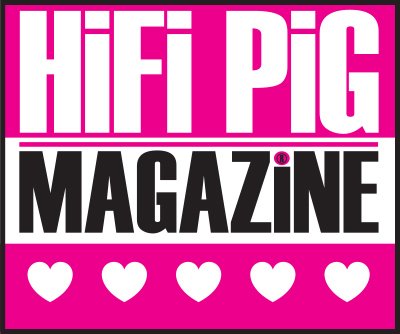
Build and Features:
Build quality is excellent and the PH1000 looks fantastic, but that is a personal opinion
Feature-rich and I think anyone would be hard pushed to find fault or something that the PH1000 didn’t provide for the serious vinyl collector or archivist
Remote is OK but not in keeping with the rest of the unit
The menu navigation can be a little jumpy at time
Plenty of inputs to allow for multi-arm/turntable setups and line inputs on the LINE model tested
Sound Quality:
Dynamic and midband-rich, though overall pretty neutral in its character allowing your cartridges to do their thing
Playing with the different EQ curves and settings changes the tone of recordings – this is not really something I’d suggest people would do but I suppose it could be seen as a degree of “tone” control
The onboard Class A preamplifier is excellent
Value For Money:
It costs eleven grand and that’s a lot of money for a phonostage. However, for that money, you get unrivalled flexibility not to be found elsewhere and the option to do away with your preamplifier.
It’s a serious investment for serious audiophiles and collectors of records and, as such, the price is what it is
We Loved:
Fabulously engaging and detailed sounding phonostage that really lets your chosen cartridges sing
Fantastic degree of flexibility
Great looking and understated
We Didn’t Love So Much:
Overkill for many
Menu selection can be a bit jumpy until you get used to it
Remote is a bit workaday
Price:
PH1000 LINE: €13,500, £11,276, $US 14,818
Elevator Pitch Review: Made in Italy the Gold Note PH1000 phonostage costs from €9,300 which is a significant outlay. However, for this money it offers a degree of flexibility I’ve not experienced elsewhere, and, as such, it is a serious proposition for the more enthusiastic vinyl collectors and archivists amongst us. Sonically it is wonderfully dynamic and open sounding with a midband presentation that will delight, though not at the expense of everything else.

Stuart Smith
Review Equipment: Technics 1200G turntable. Hana Umami, Gold Note Tuscany Red and Vertere Sabre cartridges Lab 12 power amplifier and Lab 12 pre. Cables by Tellurium Q, Atlas, Vermouth and Way. Audiovector R6 Arrete Loudspeakers.

















































